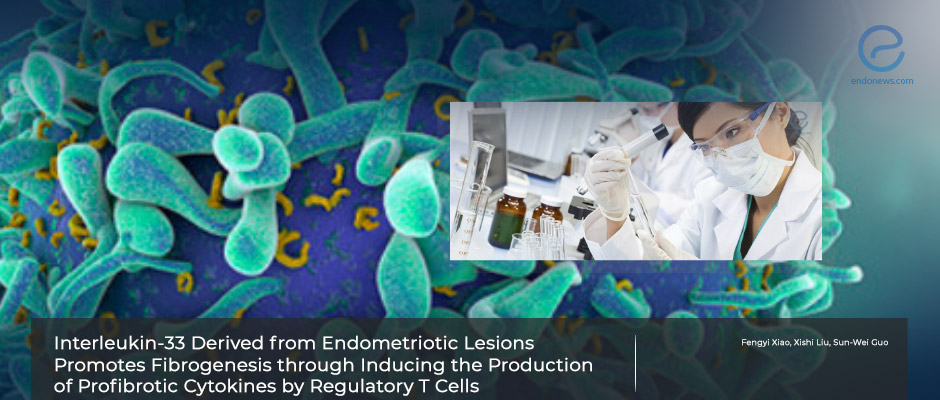The role of IL-33 and "T-regs" in lesion progression and fibrosis in endometriosis
May 25, 2023
A new link between immune regulation and fibrosis in endometriosis is revealed
Key Points
Highlight
- The interaction between IL-33 and regulatory T cells (Tregs) promotes a shift towards a Th2-dominant environment within the lesions, which is conducive to fibrogenesis and lesional progression.
- Endometriotic cells and Tregs have a collaborative role in promoting fibrosis and lesional growth in endometriosis.
Importance
- Increased expression of IL-33 in endometriotic lesions leads to the transformation of Tregs into Th2-like Tregs.
- Targeting IL-33 or Tregs could be explored as potential therapeutic approaches for endometriosis.
What’s done here
- Human endometrioma and normal endometrium tissue samples were analyzed to investigate the expression of Th2 cytokines, TGF-β1, and ST2 in Tregs.
- In vitro experiments were conducted to examine the impact of IL-33 derived from endometriotic stromal cells on Tregs and the production of profibrotic cytokines.
Key results
- Increased expression of IL-33 in endometriotic lesions promotes the transformation of Tregs into Th2-like Tregs.
- Th2-like Tregs produce higher amounts of profibrotic cytokines, including IL-4, IL-13, and TGF-β1, contributing to lesional progression and fibrogenesis in endometriosis.
- The crosstalk between endometriotic cells and Tregs, mediated by IL-33, creates a Th2-dominant microenvironment within the lesions, which further promotes fibrogenesis.
Strengths and Limitations
- Increased expression of Th2 cytokines, TGF-β1, and ST2 in Tregs from endometrioma samples was demonstrated.
- The possibility of the crosstalk between Tregs and endometriotic lesions through IL-33 was shown.
- The production of Th2 cytokines byIL-33 from endometriotic stromal cells promoted and TGF-β1 by Tregs was proven.
- The study lacks in vivo experimentation to further prove the direct effect of lesional IL-33 on Tregs.
- The amount of IL-33 produced by endometriotic stromal cells in the co-culture experiments was not quantified.
Lay Summary
It has been recognized that immune regulation likely plays a crucial role in endometriosis. Regulatory T cells (Tregs) are important immune regulators, and studies have linked Tregs to endometriosis development through signaling pathways involving TGF-β1 and PDGF. IL-33, an inflammatory molecule, has been found to play a role in tissue injury and fibrogenesis in various organs. It is elevated in endometriosis patients promoting fibrosis. It interacts with Tregs, promoting their activation and secretion of Th2 cytokines, thereby driving type 2 immune responses and lesion progression. Previous research has shown elevated levels of IL-33 in plasma, peritoneal fluid, and endometriotic lesions of patients with endometriosis. Experiments with IL-33 treatment in animal models resulted in increased lesion proliferation and size. However, there is controversy regarding the abundance of Tregs in the peritoneal fluid of women with endometriosis.
To address these gaps, Xiao et al. from Shanghai, China conducted a study that aims to investigate the interaction between endometriotic lesions, Tregs, and IL-33, with a specific focus on their involvement in fibrogenesis with a hypothesis that this crosstalk contributes to the progression of endometriosis and the development of fibrosis. The study was published in the November 2022 issue of the journal Biomedicines.
Endometriotic tissue samples from women with ovarian endometrioma and from women without endometriosis were collected. The cells used in the experiments included primary human endometriotic stromal cells, normal endometrial stromal cells, and CD4+CD25+ Tregs. Various reagents and antibodies were used, including IL-1β, tumor necrosis factor-α (TNF-α), and IL-33 antibody. RNA isolation and real-time RT-PCR were performed to evaluate mRNA expression levels, and Western blot analysis was conducted to assess protein expression. Immunofluorescence staining was used to visualize specific proteins in tissue samples. Flow cytometry was employed to analyze lymphocyte subsets. ELISA assays were carried out to quantify the levels of TGF-β1 and PDGF-BB in cell culture supernatants.
Tregs isolated from endometriotic lesions exhibited elevated levels of Th2-associated cytokines (IL-4 and IL-13) and TGF-β1, along with increased expression of the IL-33 receptor ST2. Stimulation of endometrial stromal cells with proinflammatory cytokines upregulated IL-33 expression. Co-culturing Tregs with IL-33-producing cells resulted in increased production of Th2 cytokines, which was inhibited by neutralizing IL-33. What is more, IL-33 stimulation enhanced TGF-β1 expression and secretion by Tregs, suggesting their mutual involvement in lesional fibrogenesis.
The authors state that increased expression of IL-33 in endometriotic lesions leads to the transformation of regulatory T cells (Tregs) into Th2-like Tregs, which produce higher levels of profibrotic cytokines, such as IL-4, IL-13, and TGF-β1. Targeting IL-33 or Tregs, as well as molecules involved in their interaction, could be explored as potential therapeutic approaches for endometriosis.
Research Source: https://pubmed.ncbi.nlm.nih.gov/36428461/
endometriosis IL-33 Tregs fibrosis

